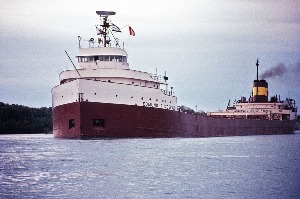
The S.S. Edmund Fitzgerald was one of the largest ships to ever roam North America's Great Lakes. It is also one of the most famous, and is widely known for its mysterious disappearance. The Fitzgerald is the largest ship to sink on Lake Superior.
November is one of the most dangerous months to sail on the Great Lakes. Frequent storms and strong winds can cause the huge lake to turn deadly. One of these deadly storms caught up to the Edmund Fitzgerald on November 10, 1975.
The ship was owned by Northwestern Mutual Insurance Company and built by Great Lakes Engineering Works in 1957 at a staggering cost of 8.4 million dollars, making it the most expensive ship to be built at that time. While the company was well known for investing money in many mineral and iron industries, Northwestern Mutual became the first American insurance company to build its own ship. The ship made its first voyage on September 24, 1958. Big cargo ships on the Great Lakes, like the Fitzgerald, were nicknamed “lakers”. Lakers transported massive amounts of salts, rocks, and grain. The Fitz generally carried taconite, a low-grade iron ore, and hauled the pellets from mines in Minnesota to steel mills near Detroit and Toledo, Ohio.
The S.S. Edmund Fitzgerald was named after the chairman of Northwestern Mutual, who had deep family ties to the Great Lakes shipping industry. Edmund Fitzgerald’s grandfather had captained a ship on the Great Lakes and his father owned a shipyard. Both had ships named after them.
The Fitzgerald carried more than 26,000 tons of iron ore pellets on its fateful and final trip. The massive ship was traveling from Superior, Wisconsin to the steel mills on Zug Island located near Detroit, Michigan. The weather had worsened, with winds reaching nearly 100 mph and waves as high as 35 feet, and an official storm warning was in place. Although she never made it into Detroit, the Big Fitz as the ship was known, remains a mystery and a legend to this day. Miles behind the Fitz sailed a second cargo ship, the Arthur M. Anderson, led by Captain Jesse Cooper, as a safety precaution.
. . . .
Aboard the Fitz was its captain, Ernest McSoley, and his crew of 28 men. McSoley was on his final voyage before retirement and was last heard assuring a crew member on the Anderson that “We are holding our own.” at 7:10pm. The ship was last seen on radar around 7:15pm and was approximately 15 miles north of Whitefish Point when it appeared to vanish. The Anderson was the last ship to be in contact with the Fitz and also the first rescue ship on the scene to search for survivors. All 29 crew members on board perished.
To this date, there is still no actual explanation of how the Fitz sank. Many experts believe that it was due to the ship having defective hatches, leading it to flood.
The Big Fitz, the Edmund Fitzgerald, was widely known throughout the Great Lakes region. Before its disappearance, crowds gathered along the shores to watch the magnificent vessel sail through the waters. Because of its massive size, the ship was given the nickname, “The Queen of the Great Lakes.” After its disappearance, it became known as the “Titanic of the Great Lakes.”
On May 20, 1976, less than a year later, the ship was spotted by a Navy underwater recovery vehicle. The Fitzgerald lies on the lake bed in two pieces. The family members of the sailors lost that night requested that something from the shipwreck be retrieved, to be used as a symbolic memorial. The ship’s bell was eventually recovered and during the annual Edmund Fitzgerald memorial ceremony, the bell tolls 30 times, 29 times for each crew member lost on November 10, 1975 and an additional 30th time for the estimated 30,000 sailors also lost on the Great Lakes.
[Source:
Mental Floss
]


Sincerely, Fred Kramer – Fred Kramer , New Franken (2021-05-26 06:49)